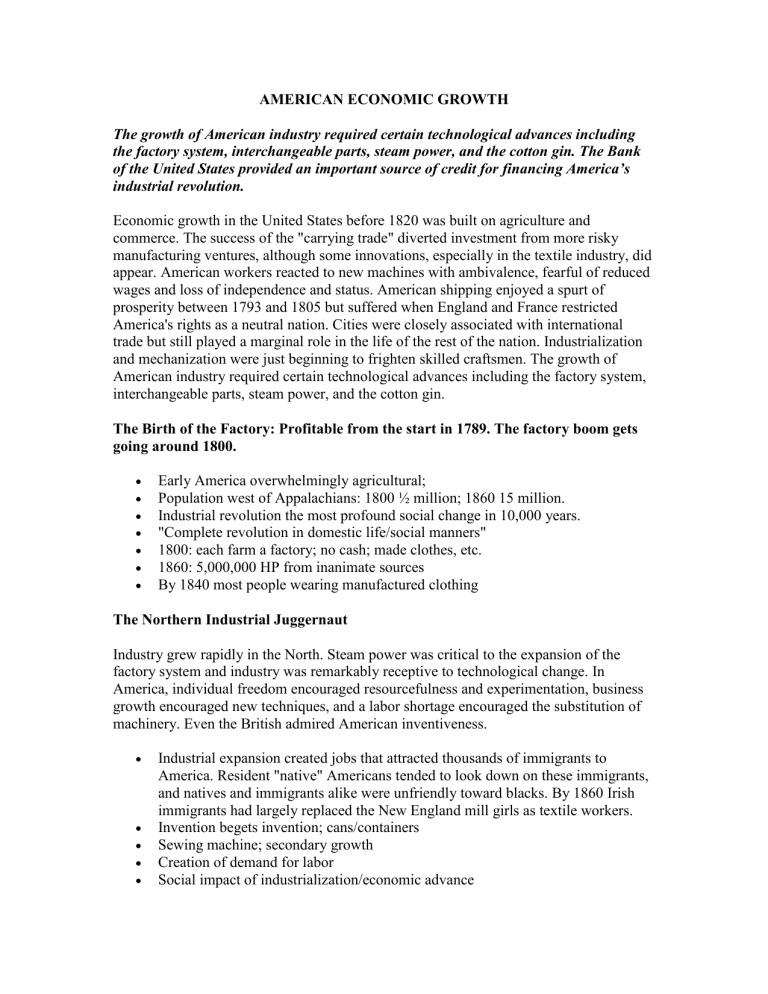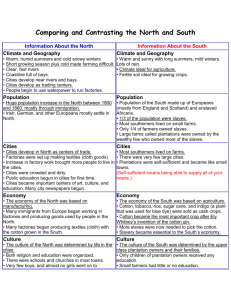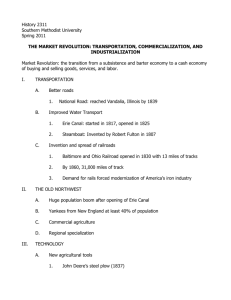american economic growth

AMERICAN ECONOMIC GROWTH
The growth of American industry required certain technological advances including the factory system, interchangeable parts, steam power, and the cotton gin. The Bank of the United States provided an important source of credit for financing America’s industrial revolution.
Economic growth in the United States before 1820 was built on agriculture and commerce. The success of the "carrying trade" diverted investment from more risky manufacturing ventures, although some innovations, especially in the textile industry, did appear. American workers reacted to new machines with ambivalence, fearful of reduced wages and loss of independence and status. American shipping enjoyed a spurt of prosperity between 1793 and 1805 but suffered when England and France restricted
America's rights as a neutral nation. Cities were closely associated with international trade but still played a marginal role in the life of the rest of the nation. Industrialization and mechanization were just beginning to frighten skilled craftsmen. The growth of
American industry required certain technological advances including the factory system, interchangeable parts, steam power, and the cotton gin.
The Birth of the Factory: Profitable from the start in 1789. The factory boom gets going around 1800.
Early America overwhelmingly agricultural;
Population west of Appalachians: 1800 ½ million; 1860 15 million.
Industrial revolution the most profound social change in 10,000 years.
"Complete revolution in domestic life/social manners"
1800: each farm a factory; no cash; made clothes, etc.
1860: 5,000,000 HP from inanimate sources
By 1840 most people wearing manufactured clothing
The Northern Industrial Juggernaut
Industry grew rapidly in the North. Steam power was critical to the expansion of the factory system and industry was remarkably receptive to technological change. In
America, individual freedom encouraged resourcefulness and experimentation, business growth encouraged new techniques, and a labor shortage encouraged the substitution of machinery. Even the British admired American inventiveness.
Industrial expansion created jobs that attracted thousands of immigrants to
America. Resident "native" Americans tended to look down on these immigrants, and natives and immigrants alike were unfriendly toward blacks. By 1860 Irish
immigrants had largely replaced the New England mill girls as textile workers.
Invention begets invention; cans/containers
Sewing machine; secondary growth
Creation of demand for labor
Social impact of industrialization/economic advance
Distribution of wealth: Rev. 45% of $ in 10% of pop;
Boston 1845: 4% own 65%; Philadelphia 1860--1% own 50%+
Relative standards widening, but absolute standards up
Telegraph: Important economic contribution; railroads needed it, also businesses for deals, orders, etc. By 1860: 50,000 miles under Western Union Telegraph
Corp. Most lines NE-NW
YANKEE INGENUITY: RESOURCEFULNESS AND EXPERIMENTATION
Americans willing to try anything; first copiers, then innovators; Oliver Evans—
automated flour mill;
Jacob Perkins—Nail-making machine; Charles Goodyear rubber
1800 41 patents; 1860 4,357 (100X); Thresher, reaper, harrows, plows, mowers, hay rakes, etc.
John Deere, McCormick, others
New Inventions: The Ice Industry (see Notes)
Whitney, Slater, Fitch’s steamboat
The Industrialization of America: Still rural, but industrialization coming; began ca. 1800.
The Birth of the Factory: Profitable from the start (1789)
The Textile Industry
Samuel Slater leaves England with Arkwright Plans in head
Water Power and Weaving
The Boston-Lowell Factories
The Persistence of the Household System
Danbury Hatters
Small Manufacturers and the Shoe Industry
Corporations: See Marshall’s Decisions (Dartmouth). 1781-1801, only 326 charters in U.S.
Charters required separate government action in each case, most for quasi-public projects
THE TRANSPORTATION BOOM: CROSSING THE ATLANTIC & CROSSING
THE CONTINENT
By the late 1840s, steamships had captured much of the Atlantic freight and passenger traffic. These British-built vessels, stronger and larger than wooden sailing ships, challenged America’s shipbuilding industry. Competition, subsidies, and new technology reduced shipping rates. Bargain rates in steerage enabled tens of thousands of Europeans to immigrate to America.
Packets—steam and sail
English iron ships superior
Foreign Commerce
Foreign commerce grew dramatically in the 1840s and 1850s.
United States mostly exported raw materials (cotton was the most valuable export), and it usually imported more (mostly manufactured goods) than it exported.
Britain was the best customer of the United States and its leading supplier.
Regularly scheduled sailing packets concentrated trade in New York and other large cities. o o o
Raw materials out, manufactures in
The Growth of New England Trade
The 19-knot clipper ship: Fast, sleek but expensive—enjoyed brief o popularity at mid-century.
Whaling industry
The Canal Boom
The Erie in New York—completed 1825 for $7 million
The Delaware and Hudson
Ohio Canals—many built, not all made money
The Emporium of the Western World: New York’s Metropolis
1818 Black Ball Line
THE RAILROADS .
Expanding Traffic
Railroads: 1830—100 mi.; 1840—3,500 mi.; 1860—30,600 mi.
Prior to Civil War no real national network, but in east several major lines exist:
NYC, PA, B&O
Overcoming Engineering Problems: Iron rails; engines that curve—the swivel
truck; the standard American engine.
Early rail travel dangerous, uncomfortable; started fires until coal appears; brakes weak
Financing the Systems
Slave labor built the South’s railroads, immigrants built the North’s.
Private investors supplied capital, particularly when their communities stood to profit from the railroad.
East-west rail lines usually required some public funding—loans, investments,
and tax exemptions.
Federal government helped by granting federal lands to states to build railroads.
Railroads profoundly affected the farmers. Location of the lines helped determine what land could be profitably cultivated. Railroad companies created farms by selling their land grants as farm sites. Prices for farm goods was high, but farm labor was scarce. Machinery appeared to ease the labor shortage. Steel plows and
mechanical reapers reduced the labor and time required to plant and harvest.
Railroads also affected cities. Chicago became the railroad center of the Midwest.
Railroads also stimulated other kinds of economic activity. It influenced real estate values, spurred regional concentration of industry, increased the size of business units, and stimulated the growth of investment banking. Railroads also revolutionized business organization and management, and they sharply reduced freight and passenger rates. Finally, railroads revolutionized western agriculture; the center of wheat production moved westward.
Access to World Markets
Effects on the Midwestern Farmer—opened new areas
Transformed land values
Midwestern cities boom
Railroads and the Sectional Conflict
The East-West Corridors transform political lines to East-West
Short Lines in the South; no rail system in South
Southerners not industrial capitalists
The Old Northwest is more agriculture oriented than NE, but
Average farm 200 acres—mostly self-owned, operated
Corn, wheat, hogs, cattle, sheep
Northeast provides markets for farm produce; Northwest for manufactured goods
THE ROLE of GOVERNMENT in INDUSTRY
Laissez faire idea popular, but government did much to assist capitalism; provided
"social overhead capital"—internal improvements, corporation laws. etc.
Erie Canal; tariffs; corporation laws; schools
Land for railroad development
Also created markets by adding territory
Corporations
: See Marshall’s Decisions, esp.
Dartmouth . 1781-1801, only 326 charters in U.S. Charters required separate government action in each case, most for quasi-public projects
MANUFACTURING BOOM
Inventions and Industrialism
Prejudice against corporations breaks down
Most states pass general laws of incorporation
The development of capital; came from NE merchant class
Banks: 1500 by 1860 w/ capital resources of $1 billion
Insurance companies also necessary to offset risks
Access to 20,000,000 people market in SW makes NE boom
CORPORATIONS AND LABOR
Labor Force early 1800s predominantly women
Early unions usually local, social, weak.
Courts unfriendly until Mass. S.C. Commonwealth v. Hunt provided precedent for other state cases
Unions gradually appear; 1828 Working Men’s Party
Worker Political parties ineffective; but some mainstreamed
A NATION OF IMMIGRANTS: Industrial expansion created jobs that attracted thousands of immigrants to America. Resident "native" Americans tended to look down on these immigrants, and natives and immigrants alike were unfriendly toward blacks. By
1860 Irish immigrants had largely replaced the New England mill girls as textile workers.
Invention begets invention; cans/containers
Sewing machine; secondary growth
Creation of demand for labor
Social impact of industrialization/economic advance
Distribution of wealth: Rev. 45% of $ in 10% of pop;
Boston 1845: 4% own 65%; Philadelphia 1860--1% own 50%+
Relative standards widening, but absolute standards up
The Irish Wave; potato blight
Displaced women in factories
Urban Squalor: worst conditions in history
A Land of Opportunity?
WORKING CLASS PEOPLE: Immigrants and factory workers often lived in crowded slums in industrial cities. Life there was squalid and dangerous. Low wages meant wives and children of most factory workers also had to work to help the family survive. Most workers did not belong to unions. Early unions and workingman’s political parties were virtually destroyed by the depression of the late 1830s. Nevertheless, in the 1840s and
1850s many states passed laws that both limited the workday to ten hours and regulated child labor. Before 1860 most labor unions were small and local. Laborers rarely thought of themselves as members of a permanent working class. Republican values, a high rate of social and geographical mobility, and the ready availability of woman, child, and immigrant labor made labor organization difficult.
Mid-19 th
century America was a land of opportunity with a relatively high standard of living. Yet, there was also an underclass of poorly paid and unskilled workers, mostly immigrants. Toward these, middle-class Americans were indifferent or unaware. Society became more stratified, the distance between the top and bottom widened. Still, the ideology of egalitarian democracy endured.
THE ECONOMY OF THE SOUTH
The Cotton South: By the middle of the 19 th
century the United States was developing a national market economy marked by inter-regional dependence. The South remained
agricultural. Cotton was king in the Deep South, but the Upper South produced tobacco and wheat and a growing diversity of other crops.
Myths about the Old South [From Tindall]
The kind "Massa" and contented darkies, gallant young men and radiant southern
belles
Poor white trash, dirt poor, scratching in the clay hills; masses reduced to ignorance, degeneracy by slave system
Corrupt opulence based on human exploitation; the haughty slave owner as cattle breeder; the seraglio in the slave quarters; beatings; hardships; women suffer in silence; slaves yearning for freedom o Poets have explained South better than historians.
PLANTATION LIFE .
A plantation resembled a small village.
Sexual division of labor was less evident in the South than in the North, and southern women had immense responsibilities on the plantation.
Both slave men and women worked as field hands. Slave children typically went to the fields around age ten.
Impact of Cotton on the South
In 1810 South had as much manufacturing as the North!
Slavery on the decline in 1780s, early 90s; 10,000 freed in Virginia about that time
The Need for Cash Crops; the Price of Cotton and the Cotton Boom. Whitney’s
Cotton Gin 1793
North is South’s Middleman: Insurance, transport, marketing o Panic of 1819: Prices in Liverpool on Cotton sink o 1816-1819 Banking frauds; bank blamed for panic o Land speculation based on 1800 law; prices crash
King Cotton : 1812—150,000 bales; 1860—3.8 million bales
Voracious appetite of British, French looms
New Land in Southwest; prices climb gradually
Large numbers of livestock; maybe 50% overall
SLAVERY
As the cotton culture spread westward, slavery strengthened its hold on the South. The demand for slaves was greatest in the Deep South, and the Upper South sold its slaves
"down the river" at ever higher prices. Slave trading was a lucrative business, but it sometimes led to the breakup of slave families. As the price of slaves increased, only wealthy southerners could afford to buy them, so by 1860 only one- quarter of southern families owned slaves. Slavery was profitable, but it kept southern capital from being
invested in trade and manufacturing. Thus, northern business firms handled the marketing of the southern cotton crop. At bottom, slavery was a stagnant and inefficient labor system that wasted talent and energy.
ANTEBELLUM PLANTATION LIFE . A plantation resembled a small village. Sexual division of labor was less evident in the South than in the North, and southern women had immense responsibilities on the plantation. Both slave men and women worked as field hands. Slave children typically went to the fields around age ten.
THE PLANTATION SYSTEM :
Staple crops
Rice: Much capital outlay; large plantations;
Sugar: machinery; needed tariff protection; Hemp
King Cotton: 1812 150,000 bales; 1860 3.8 million bales o Voracious appetite of British, French looms o New Land in Southwest; prices climb gradually o Large numbers of livestock; maybe 50% overall
Foodstuffs: South produced much food, fed self, others
Corn, wheat; alternate between staples, food crops
Less than great prosperity; staples deplete soil—tobacco, corn, cotton; erosion;
shift westward as much of Southeast abandoned.
Agricultural reform attempted; soil treatment.
SOUTHERN INDUSTRY : Diversification as salvation
There was some manufacturing in the antebellum South. Cotton and water power made textile manufacturing profitable. But southern manufacturing was small in scale compared with the North; only 15 percent of the nation’s manufactured goods came from the South in 1860.
In 1810 South has more manufactures than New England; cotton displaced everything else after War of 1812. Meanwhile industry booms in North;
Southern capital put into cotton and slaves; by 1850 North far ahead, and South becomes economically dependent on North.
Economic reformers (DeBow, Gregg) pushed textiles, etc. Tredegar Iron Works;
Prattville, Alabama. Concentrated in upper South; slaves used; High per capita income ($184) compares well with rest of world
WHITE SOCIETY IN THE SOUTH
Generally stagnant; no innovation, immigration.
Planters with 20+ slaves—46,000 of 380,000 slave holders; 8,000 w/ 50; 2300 w/
100; 11 w/ 500; 1 w/ 1000+
Wealth and leisure for many, not all; hard work
Women work hard too: "No slave like a wife"
Attitude towards slaves determines their life;
Middle Class: Overseers; yeoman farmers; businessmen
Poor Whites: scratch farmers, wanderers, etc.
Professionals; lawyers, doctors, etc. in planter class
40,000 imported 1804-1808; Abolition or Colonization? Liberia established
Northern Racism: Blacks had limited legal rights
As the cotton culture spread westward, slavery strengthened its hold on the South.
The demand for slaves was greatest in the Deep South, and the Upper South sold its slaves "down the river" at ever higher prices.
Slave trading was a lucrative business, but often led to the breakup of slave families;
As the price of slaves increased, only wealthy southerners could afford to buy them;
By 1860, only one-quarter of southern families owned slaves;
Slavery was profitable, but it kept southern capital from being invested in trade and manufacturing. Thus, northern business firms handled the marketing of the southern cotton crop.
At bottom, slavery was a stagnant and inefficient labor system that wasted talent and energy.








